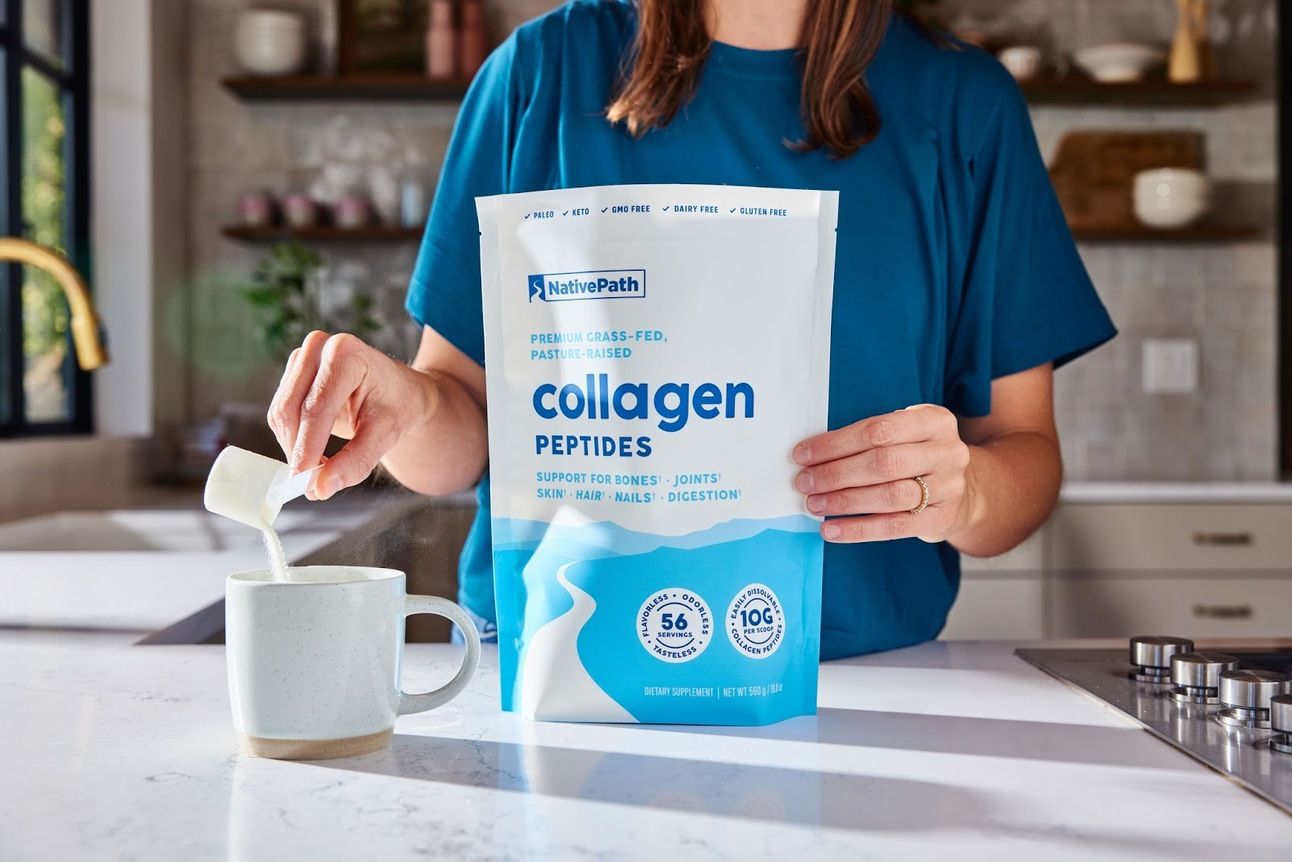Not a fan of toxic black mold, but also not a fan of having to bleach it into oblivion? A dehumidifier is your best prophylactic ally.
Note that heating alone won’t prevent it; a humid house can soon grow fascinating new cultures, and you probably don’t want that.
In A Rush?
Today’s 30-Second Summary
If you don’t have time to read the whole email today, here are some key takeaways:
Some cookware materials are a lot healthier than others!
Today’s main feature examines the dangers (or in some case, non-dangers) of various kinds of cookware, including stainless steel, non-stick, aluminum, copper, ceramic, and cast iron. Ultimately, cast iron is probably best for most people and non-stick is probably worst for everyone, but there are some close runners-up!
As we age, our collagen levels tend to get depleted more easily. Collagen is important not just for youthful good looks, but also for the health of bones and joints.
Today’s sponsor NativePath are offering high-quality collagen without additives or harmful impurities
Today’s featured recipe is for chili chestnut, sweet apricot, and whipped feta toasts—this is a delightful breakfast or light lunch option, full of gut-healthy ingredients and a fair list of healthy polyphenols too.
Read on to learn more about these things, or click here to visit our archive
A Word To The Wise
Watch and Learn
Nutrition To Combat Lymphedema & Lipedema
Dr. Kelly Sturm is a rehab specialist (Doctor of Physical Therapy), and also a certified lymphedema therapist. Here’s what helps her patients with lymphedema and lipedema:
Prefer text? The above video will take you to a 10almonds page with a text-overview, as well as the video!
Mythbusting Friday
Mythbusting Cookware Materials

In Wednesday’s newsletter, we asked you what kind of cookware you mostly use, and got the above-depicted, below-described, set of responses:
About 45% said stainless steel
About 21% said cast iron
About 15% said non-stick (e.g. Teflon)
About 9% said enamel
About 6% said aluminum
And 1 person selected “something else”, but then commented to the contrary, writing “I use all of the above”
So, what does the science say about these options?
Stainless steel cookware is safe: True or False?
True! Assuming good quality and normal use, anyway. There really isn’t a lot to say about this, because it’s very unexciting. So long as it is what it is labelled as: there’s nothing coating it, nothing comes out of it unless you go to extremes*, and it’s easy to clean.
*If you cook for long durations at very high temperatures, it can leach nickel and chromium into food. What this means in practical terms: if you are using stainless steel to do deep-frying, then maybe stop that, and also consider going easy on deep-frying in general anyway, because obviously deep-frying is unhealthy for other reasons.
Per normal use, however: pretty much the only way (good quality) stainless steel cookware will harm you is if you touch it while it’s hot, or if it falls off a shelf onto your head.
That said, do watch out for cheap stainless steel cookware that can contain a lot of impurities, including heavy metals. Since you probably don’t have a mass spectrometer and/or chemistry lab at home to check for those impurities, your best guard here is simply to buy from a reputable brand with credible certifications.
Ceramic cookware is safe: True or False?
True… Most of the time! Ceramic pans usually have metal parts and a ceramic cooking surface coated with a very thin layer of silicon. Those metal parts will be as safe as the metals used, so if that’s stainless steel, you’re just as safe as the above. As for the silicon, it is famously inert and body-safe (which is why it’s used in body implants).
However: ceramic cookware that doesn’t have an obvious metal part and is marketed as being pure ceramic, will generally be sealed with some kind of glaze that can leach heavy metals contaminants into the food; here’s an example:
Copper cookware is safe: True or False?
False! This is one we forgot to mention in the poll, as one doesn’t see a lot of it nowadays. The copper from copper pans can leach into food. Now, of course copper is an important mineral that we must get from our diet, but the amount of copper that that can leach into food from copper pans is far too much, and can induce copper toxicity.
In addition, copper cookware has been found to be, on average, highly contaminated with lead:
Non-stick cookware contaminates the food with microplastics: True or False?
True! If we were to discuss all the common non-stick contaminants here, this email would no longer fit (there’s a size limit before it gets clipped by most email services).
Suffice it to say: the non-stick coating, polytetrafluoroethylene, is itself a PFAS, that is to say, part of the category of chemicals considered environmental pollutants, and associated with a long list of health issues in humans (wherein the level of PFAS in our bloodstream is associated with higher incidence of many illnesses):
You may have noticed, of course, that the “non-stick” coating doesn’t stick very well to the pan, either, and will tend to come off over time, even if used carefully.
Also, any kind of wet cooking (e.g. saucepans, skillets, rice cooker inserts) will leach PFAS into the food. In contrast, a non-stick baking tray lined with baking paper (thus: a barrier between the tray and your food) is really not such an issue.
We wrote about PFAS before, so if you’d like a more readable pop-science article than the scientific paper above, then check out:
Aluminum cookware contaminates the food with aluminum: True or False?
True! But not usually in sufficient quantities to induce aluminum toxicity, unless you are aluminum pans Georg who eats half a gram of aluminum per day, who is a statistical outlier and should not be counted.
That’s a silly example, but an actual number; the dose required for aluminum toxicity in blood is 100mg/L, and you have about 5 liters of blood.
Unless you are on kidney dialysis (because 95% of aluminum is excreted by the kidneys, and kidney dialysis solution can itself contain aluminum), you will excrete aluminum a lot faster than you can possibly absorb it from cookware. On the other hand, you can get too much of it from it being a permitted additive in foods and medications, for example if you are taking antacids they often have a lot of aluminum oxide in them—but that is outside the scope of today’s article.
However, aluminum may not be the real problem in aluminum pans:
❝In addition, aluminum (3.2 ± 0.25 to 4.64 ± 0.20 g/kg) and copper cookware (2.90 ± 0.12 g/kg) were highly contaminated with lead.
The time and pH-dependent study revealed that leaching of metals (Al, Pb, Ni, Cr, Cd, Cu, and Fe, etc.) into food was predominantly from anodized and non-anodized aluminum cookware.
More metal leaching was observed from new aluminum cookware compared to old. Acidic food was found to cause more metals to leach during cooking.❞
Cast iron cookware contaminates the food with iron: True or False?
True, but unlike with the other metals discussed, this is purely a positive, and indeed, it’s even recommended as a good way to fortify one’s diet with iron:
The only notable counterpoint we could find for this is if you have hemochromatosis, a disorder in which the body is too good at absorbing iron and holding onto it.
Thinking of getting some new cookware?
Here are some example products of high-quality safe materials on Amazon, but of course feel free to shop around:
*it says “non-stick” in the description, but don’t worry, it’s ceramic, not Teflon etc, and is safe
Take care!
Our Sponsors Make This Publication Possible
Restore Your Youthful Glow
Collagen loss as you age may result in weaker joints, wrinkles, and a decline in overall vitality. It’s a natural process, but that doesn’t mean there’s nothing you can do to slow it down. Replenishing collagen can restore your vibrancy and power, and the journey starts with NativePath.
NativePath’s grass-fed collagen powder features a premium formula that absorbs rapidly, rebuilding strength and enhancing beauty from within. Simply add one or two scoops to your daily routine and witness the transformative effects.
Please do visit our sponsors—they help keep 10almonds free
This Or That?
Vote on Which is Healthier
Yesterday we asked you to choose between pistachios and pine nuts—we picked the pistachios (click here to read about why), as did 69% of you!
Now for today’s choice:
Click on whichever you think is better for you!
Bonus (Sponsored) Recommendation
We know 10almonds readers love learning in a convenient, bite-size fashion. Here’s a list of some other newsletters our readers also enjoy; check them out!
Recipes Worth Sharing
Chili Chestnut, Sweet Apricot, & Whipped Feta Toasts
This is a delightful breakfast or light lunch option, full of gut-healthy ingredients and a fair list of healthy polyphenols too:
Click below for our full recipe, and learn its secrets:
Penny For Your Thoughts?
What did you think of today's newsletter?
May today see you well-prepared for the coming weekend,
The 10almonds Team








